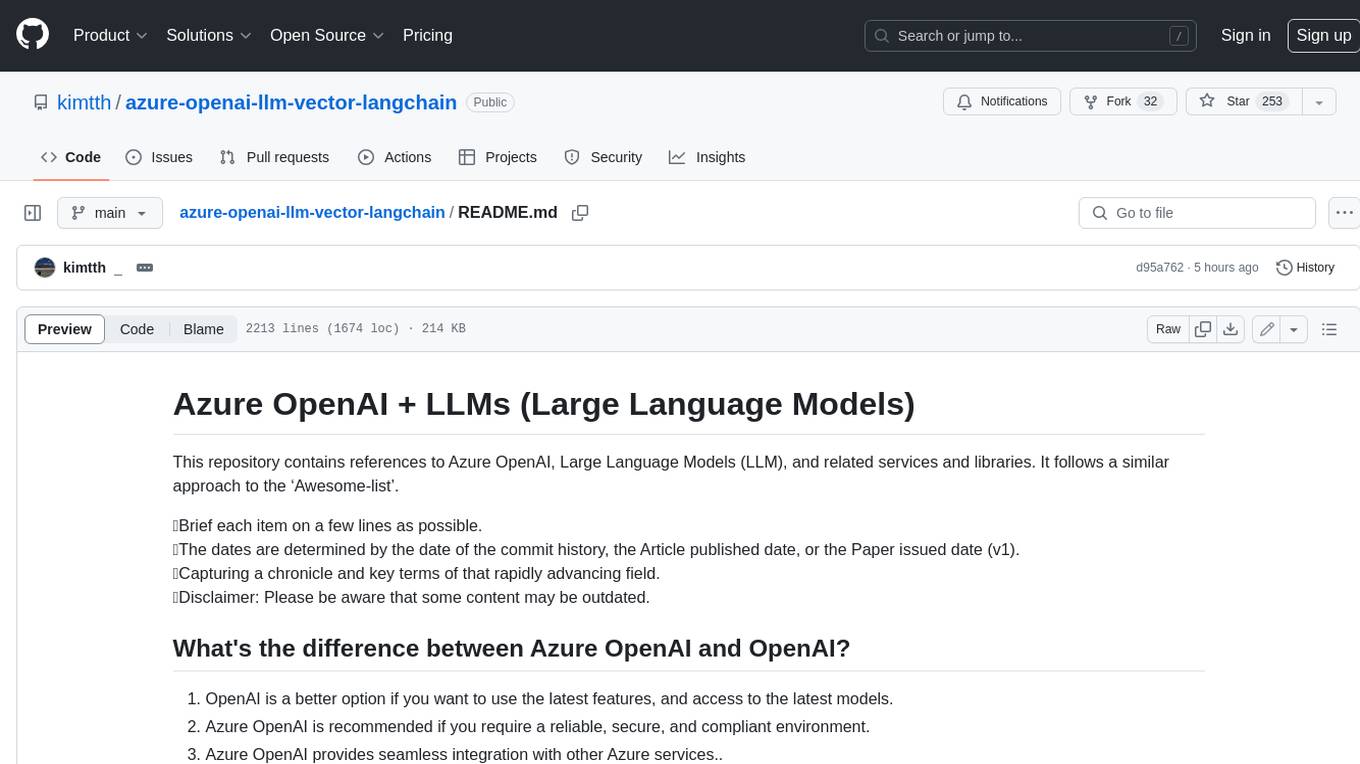
LakeSoul
LakeSoul is an end-to-end, realtime and cloud native Lakehouse framework with fast data ingestion, concurrent update and incremental data analytics on cloud storages for both BI and AI applications.
Stars: 3004
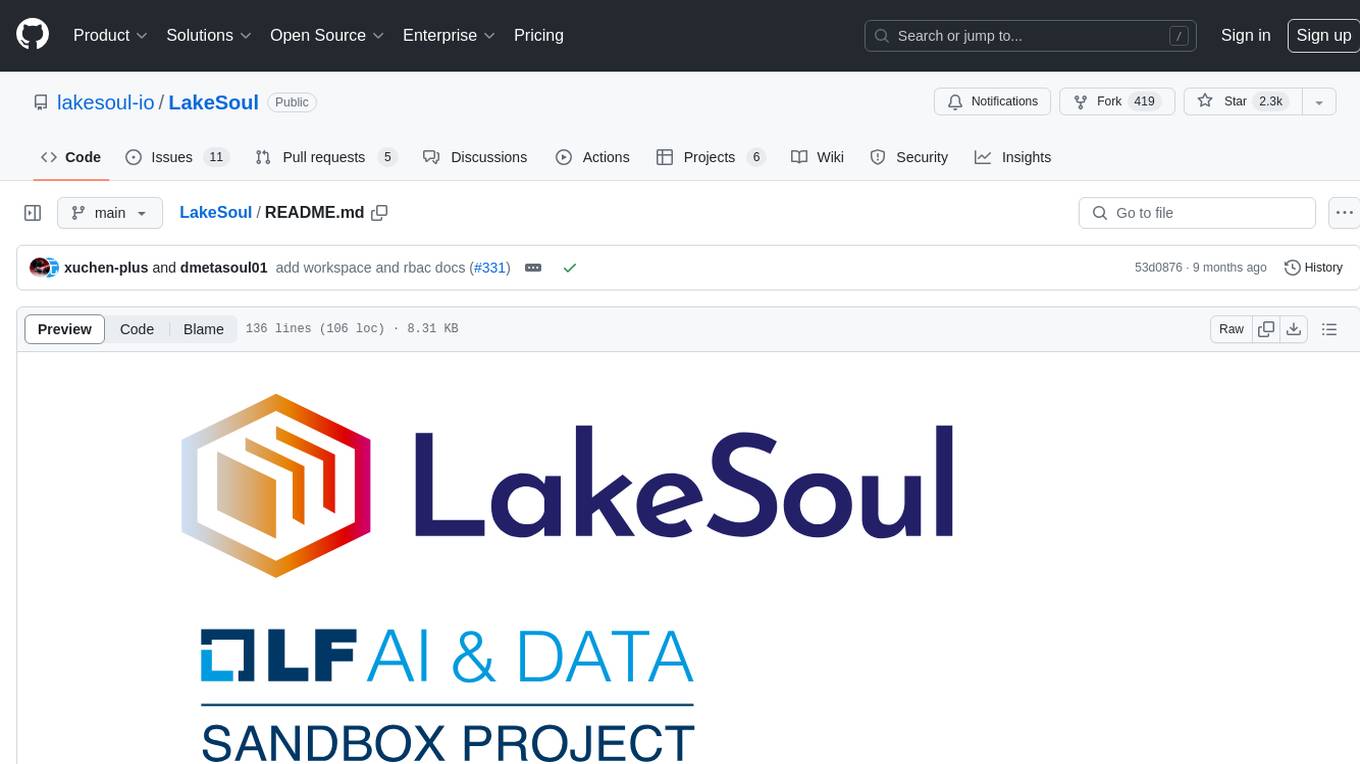
LakeSoul is a cloud-native Lakehouse framework that supports scalable metadata management, ACID transactions, efficient and flexible upsert operation, schema evolution, and unified streaming & batch processing. It supports multiple computing engines like Spark, Flink, Presto, and PyTorch, and computing modes such as batch, stream, MPP, and AI. LakeSoul scales metadata management and achieves ACID control by using PostgreSQL. It provides features like automatic compaction, table lifecycle maintenance, redundant data cleaning, and permission isolation for metadata.
README:
2025.09: LakeSoul has released newest version 3.0.0, check out our release note
LakeSoul is a cloud-native Lakehouse framework that supports scalable metadata management, ACID transactions, efficient and flexible upsert operation, schema evolution, and unified streaming & batch processing.
LakeSoul supports multiple computing engines to read and write lake warehouse table data, including Spark, Flink, Presto, and PyTorch, and supports multiple computing modes such as batch, stream, MPP, and AI. LakeSoul supports storage systems such as HDFS and S3.
LakeSoul was originally created by DMetaSoul company and was donated to Linux Foundation AI & Data as a sandbox project since May 2023.
LakeSoul implements incremental upserts for both row and column and allows concurrent updates.
LakeSoul uses LSM-Tree like structure to support updates on hash partitioning table with primary key, and achieves very high write throughput while providing optimized merge on read performance (refer to Performance Benchmarks). LakeSoul scales metadata management and achieves ACID control by using PostgreSQL.
LakeSoul uses Rust to implement the native metadata layer and IO layer, and provides C/Java/Python interfaces to support the connecting of multiple computing frameworks such as big data and AI.
LakeSoul supports concurrent batch or streaming read and write. Both read and write supports CDC semantics, and together with auto schema evolution and exacly-once guarantee, constructing realtime data warehouses is made easy.
LakeSoul supports multi-workspace and RBAC. LakeSoul uses Postgres's RBAC and row-level security policies to implement permission isolation for metadata. Together with Hadoop users and groups, physical data isolation can be achieved. LakeSoul's permission isolation is effective for SQL/Java/Python jobs.
LakeSoul supports automatic disaggregated size-tiered multi-level compaction, automatic table life cycle maintenance, automatic data asset statistics, and automatic redundant data cleaning, reducing operation costs and improving usability.
More detailed features please refer to our doc page: Documentations
Follow the Quick Start to quickly set up a test env.
Please find tutorials in doc site:
- Checkout Examples of Python Data Processing and AI Model Training on LakeSoul on how LakeSoul connecting AI to Lakehouse to build a unified and modern data infrastructure.
- Checkout LakeSoul Flink CDC Whole Database Synchronization Tutorial on how to sync an entire MySQL database into LakeSoul in realtime, with auto table creation, auto DDL sync and exactly once guarantee.
- Checkout Flink SQL Usage on using Flink SQL to read or write LakeSoul in both batch and streaming mode, with the supports of Flink Changelog Stream semantics and row-level upsert and delete.
- Checkout Multi Stream Merge and Build Wide Table Tutorial on how to merge multiple stream with same primary key (and different other columns) concurrently without join.
- Checkout Upsert Data and Merge UDF Tutorial on how to upsert data and Merge UDF to customize merge logic.
- Checkout Snapshot API Usage on how to do snapshot read (time travel), snapshot rollback and cleanup.
- Checkout Incremental Query Tutorial on how to do incremental query in Spark in batch or stream mode.
Please find usage documentations in doc site: Usage Doc
- Data Science and AI
- [x] Native Python Reader (without PySpark)
- [x] PyTorch Dataset and distributed training
- Meta Management (#23)
- [x] Multiple Level Partitioning: Multiple range partition and at most one hash partition
- [x] Concurrent write with auto conflict resolution
- [x] MVCC with read isolation
- [x] Write transaction (two-stage commit) through Postgres Transaction
- [x] Schema Evolution: Column add/delete supported
- Table operations
- [x] LSM-Tree style upsert for hash partitioned table
- [x] Merge on read for hash partition with upsert delta file
- [x] Copy on write update for non hash partitioned table
- [x] Automatic Disaggregated Compaction Service
- Data Warehousing
- Spark Integration
- [x] Table/Dataframe API
- [x] SQL support with catalog except upsert
- [x] Query optimization
- [x] Shuffle/Join elimination for operations on primary key
- [x] Merge UDF (Merge operator)
- [x] Merge Into SQL support
- [x] Merge Into SQL with match on Primary Key (Merge on read)
- Flink Integration and CDC Ingestion (#57)
- [x] Table API
- [x] Batch/Stream Sink
- [x] Batch/Stream source
- [x] Stream Source/Sink for ChangeLog Stream Semantics
- [x] Exactly Once Source and Sink
- [x] Flink CDC
- [x] Auto Schema Change (DDL) Sync
- [x] Auto Table Creation (depends on #78)
- [x] Support sink multiple source tables with different schemas (#84)
- [x] Table API
- Hive Integration
- [x] Export to Hive partition after compaction
- [x] Apache Kyuubi (Hive JDBC) Integration
- Realtime Data Warehousing
- [x] CDC ingestion
- [x] Time Travel (Snapshot read)
- [x] Snapshot rollback
- [x] Automatic global compaction service
- [x] MPP Engine Integration (depends on #66)
- [x] Presto
- [x] Compatibility with Presto Native Execution(with Velox)
- [x] Apache Doris
- Cloud and Native IO (#66)
- [x] Object storage IO optimization
- [x] Native vectorized merge on read
- [x] Multi-layer storage classes support with local-disk data cache
Please feel free to open an issue or dicussion if you have any questions.
Join our Discord server for discussions.
Email us at [email protected].
LakeSoul is opensourced under Apache License v2.0.
For Tasks:
Click tags to check more tools for each tasksFor Jobs:
Alternative AI tools for LakeSoul
Similar Open Source Tools

LakeSoul
LakeSoul is a cloud-native Lakehouse framework that supports scalable metadata management, ACID transactions, efficient and flexible upsert operation, schema evolution, and unified streaming & batch processing. It supports multiple computing engines like Spark, Flink, Presto, and PyTorch, and computing modes such as batch, stream, MPP, and AI. LakeSoul scales metadata management and achieves ACID control by using PostgreSQL. It provides features like automatic compaction, table lifecycle maintenance, redundant data cleaning, and permission isolation for metadata.
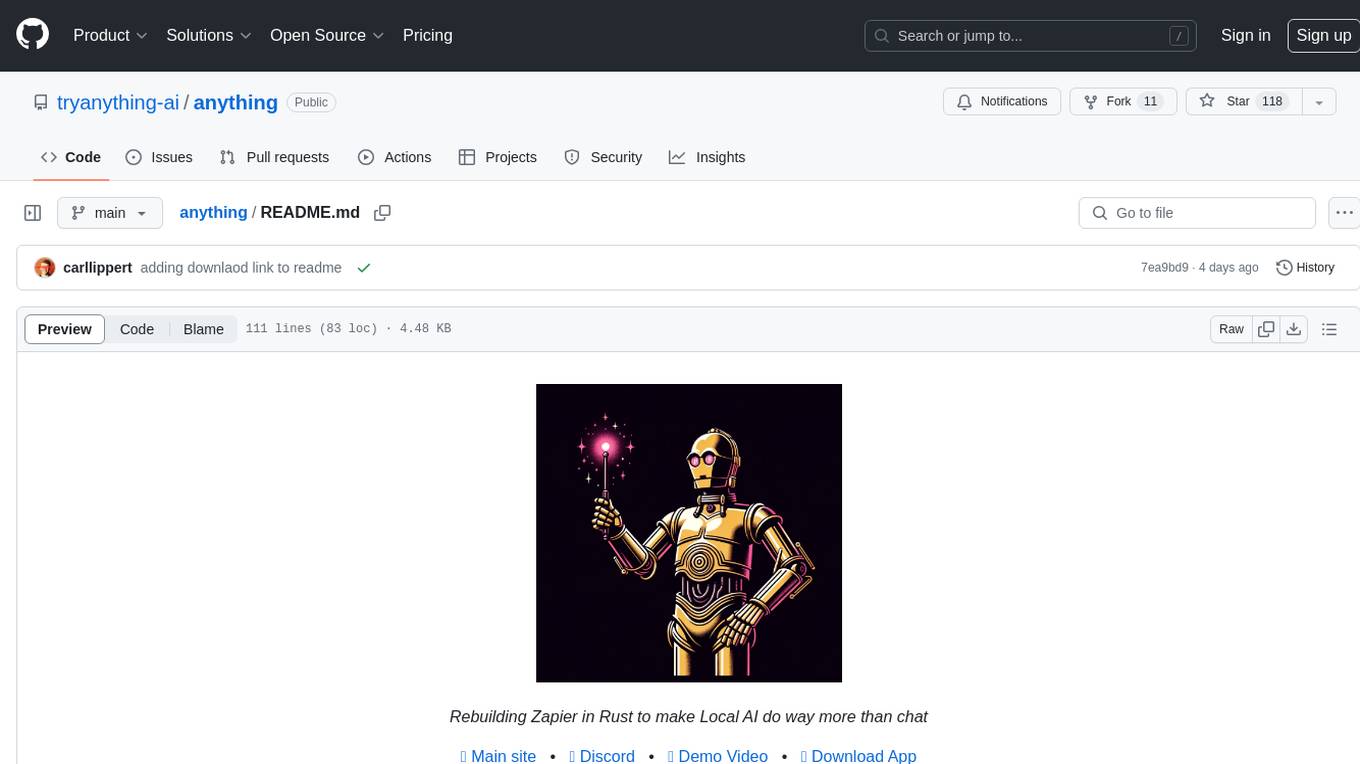
anything
Anything is an open automation tool built in Rust that aims to rebuild Zapier, enabling local AI to perform a wide range of tasks beyond chat functionalities. The tool focuses on extensibility without sacrificing understandability, allowing users to create custom extensions in Rust or other interpreted languages like Python or Typescript. It features an embedded SQLite DB, a WYSIWYG editor, event system, cron trigger, HTTP and CLI extensions, with plans for additional extensions like Deno, Python, and Local AI. The tool is designed to be user-friendly, with a file-first state approach, portable triggers, actions, and flows, and a human-centric file and folder naming convention. It does not require Docker, making it easy to run on low-powered devices for 24/7 self-hosting. The event processing is focused on simplicity and visibility, with extensibility through custom extensions and a marketplace for templates, actions, and triggers.

DocsGPT
DocsGPT is an open-source documentation assistant powered by GPT models. It simplifies the process of searching for information in project documentation by allowing developers to ask questions and receive accurate answers. With DocsGPT, users can say goodbye to manual searches and quickly find the information they need. The tool aims to revolutionize project documentation experiences and offers features like live previews, Discord community, guides, and contribution opportunities. It consists of a Flask app, Chrome extension, similarity search index creation script, and a frontend built with Vite and React. Users can quickly get started with DocsGPT by following the provided setup instructions and can contribute to its development by following the guidelines in the CONTRIBUTING.md file. The project follows a Code of Conduct to ensure a harassment-free community environment for all participants. DocsGPT is licensed under MIT and is built with LangChain.
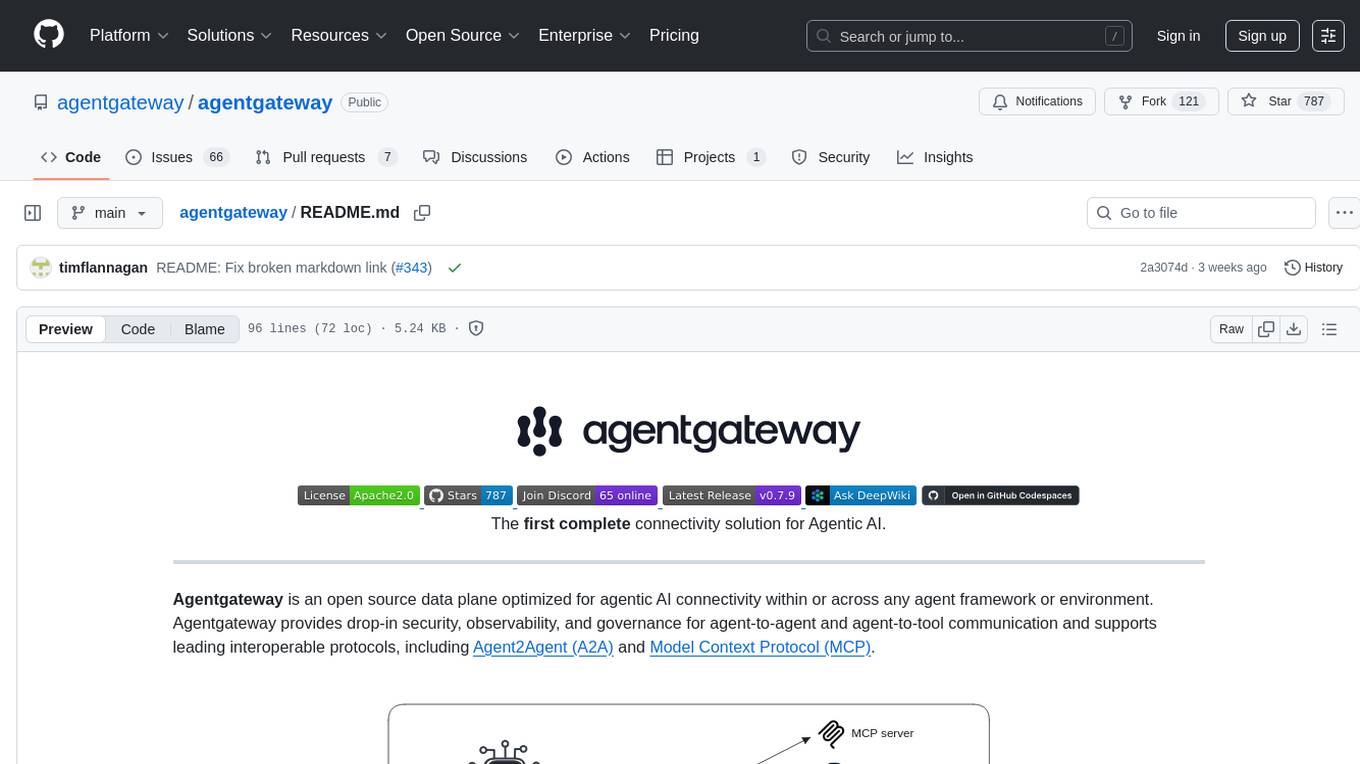
agentgateway
Agentgateway is an open source data plane optimized for agentic AI connectivity within or across any agent framework or environment. It provides drop-in security, observability, and governance for agent-to-agent and agent-to-tool communication, supporting leading interoperable protocols like Agent2Agent (A2A) and Model Context Protocol (MCP). Highly performant, security-first, multi-tenant, dynamic, and supporting legacy API transformation, agentgateway is designed to handle any scale and run anywhere with any agent framework.
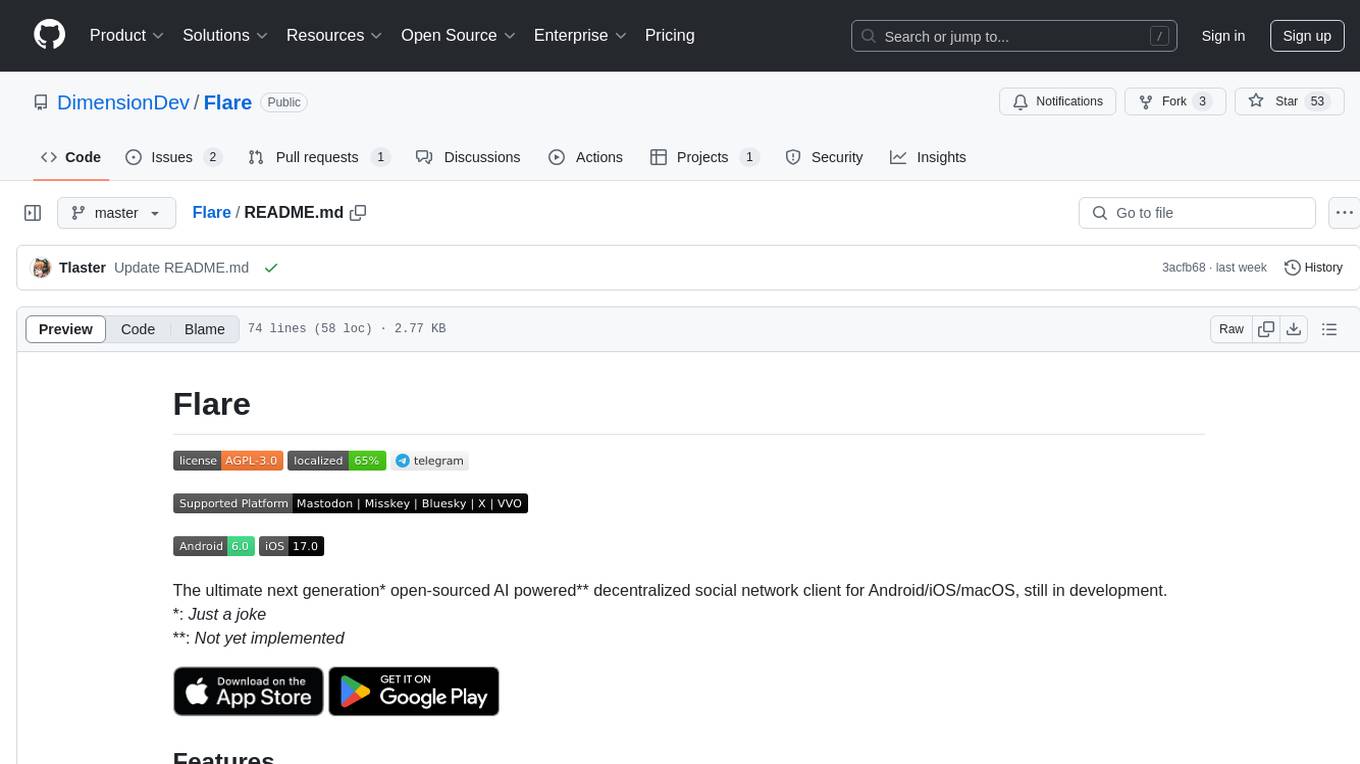
Flare
Flare is an open-source AI-powered decentralized social network client for Android/iOS/macOS, consolidating multiple social networks into one platform. It allows cross-posting content, ensures privacy, and plans to implement features like mixed timeline, AI-powered functions, and support for various platforms. The project is in active development and aims to provide a seamless social networking experience for users.

genai-os
Kuwa GenAI OS is an open, free, secure, and privacy-focused Generative-AI Operating System. It provides a multi-lingual turnkey solution for GenAI development and deployment on Linux and Windows. Users can enjoy features such as concurrent multi-chat, quoting, full prompt-list import/export/share, and flexible orchestration of prompts, RAGs, bots, models, and hardware/GPUs. The system supports various environments from virtual hosts to cloud, and it is open source, allowing developers to contribute and customize according to their needs.
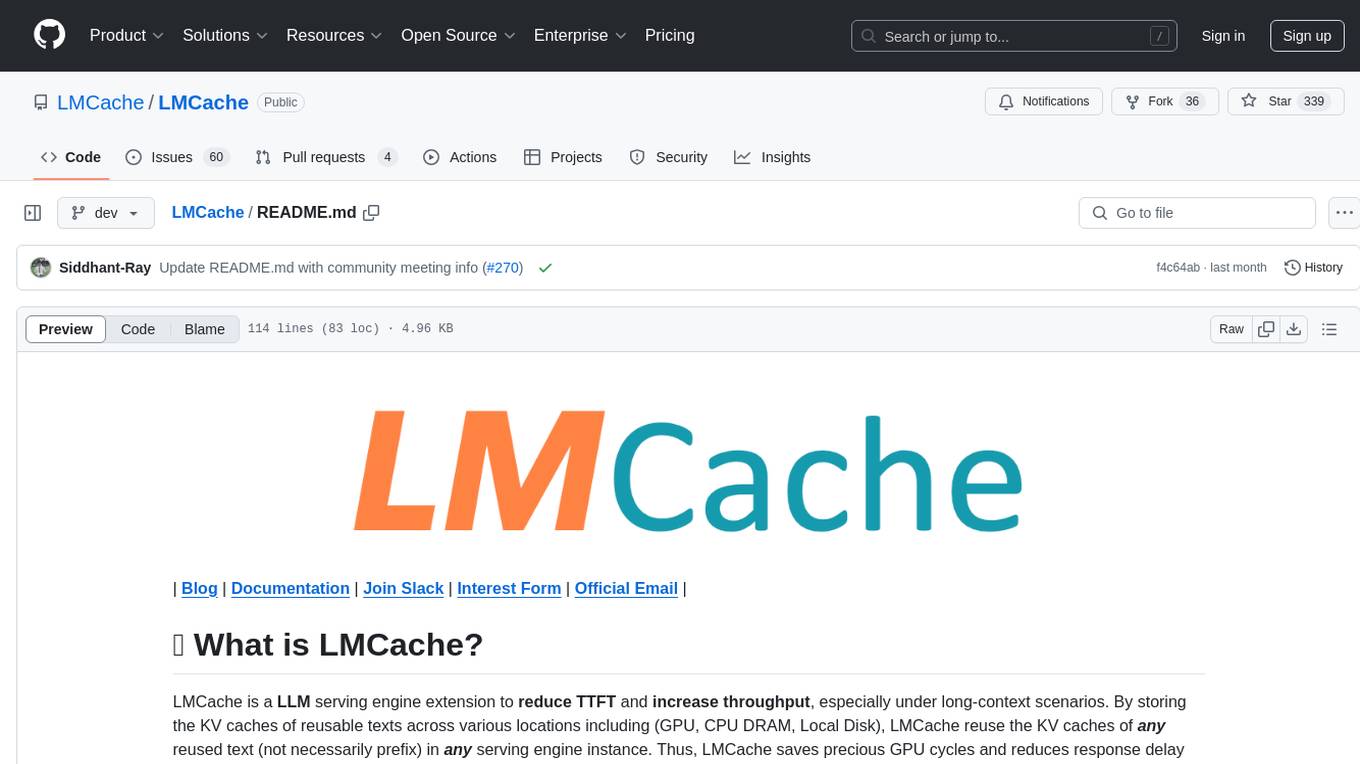
LMCache
LMCache is a serving engine extension designed to reduce time to first token (TTFT) and increase throughput, particularly in long-context scenarios. It stores key-value caches of reusable texts across different locations like GPU, CPU DRAM, and Local Disk, allowing the reuse of any text in any serving engine instance. By combining LMCache with vLLM, significant delay savings and GPU cycle reduction are achieved in various large language model (LLM) use cases, such as multi-round question answering and retrieval-augmented generation (RAG). LMCache provides integration with the latest vLLM version, offering both online serving and offline inference capabilities. It supports sharing key-value caches across multiple vLLM instances and aims to provide stable support for non-prefix key-value caches along with user and developer documentation.
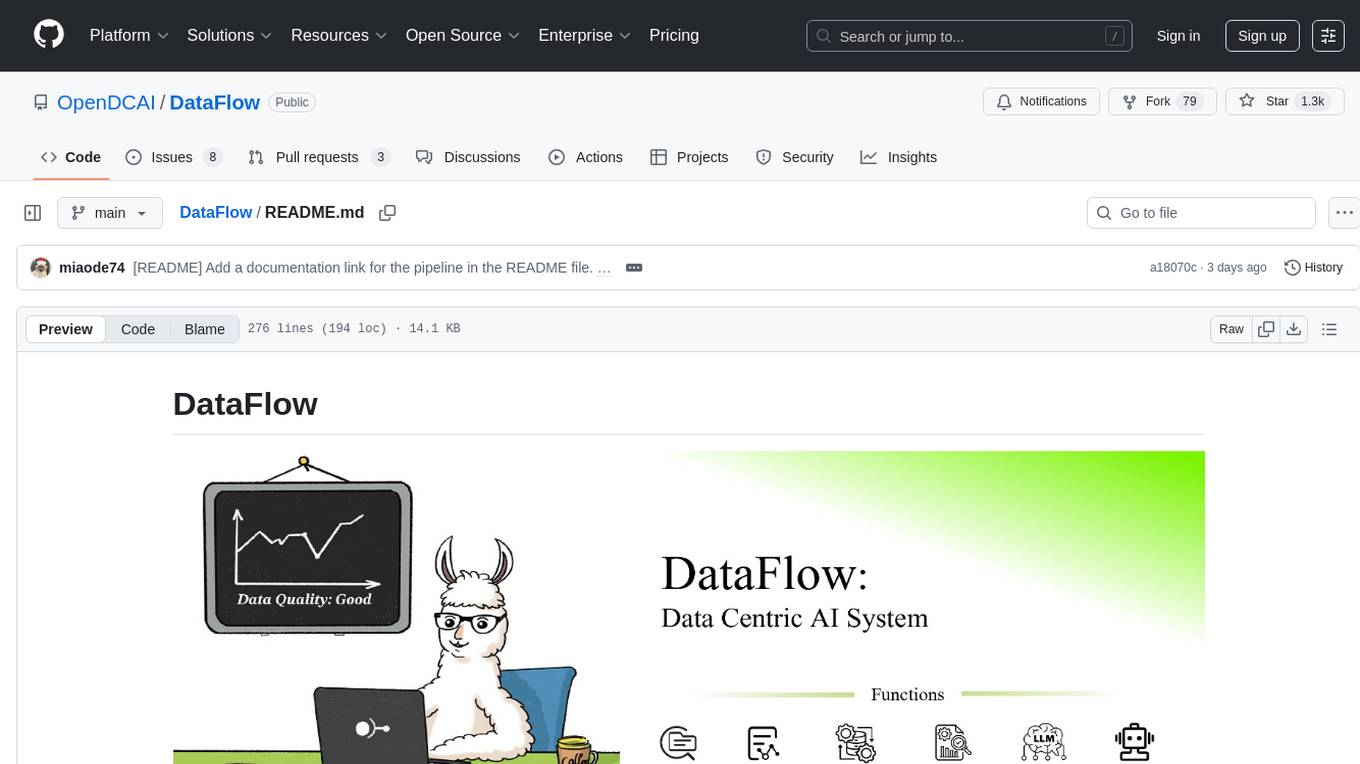
DataFlow
DataFlow is a data preparation and training system designed to parse, generate, process, and evaluate high-quality data from noisy sources, improving the performance of large language models in specific domains. It constructs diverse operators and pipelines, validated to enhance domain-oriented LLM's performance in fields like healthcare, finance, and law. DataFlow also features an intelligent DataFlow-agent capable of dynamically assembling new pipelines by recombining existing operators on demand.
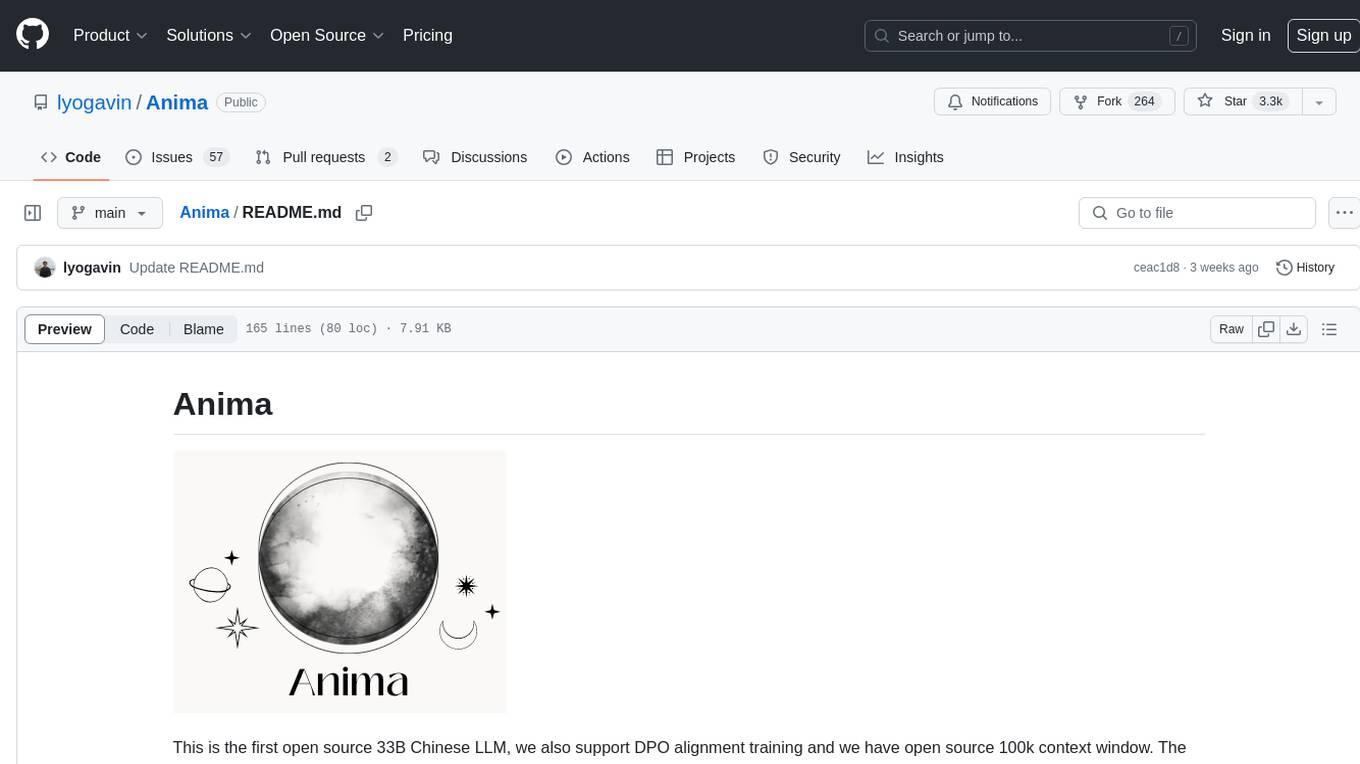
Anima
Anima is the first open-source 33B Chinese large language model based on QLoRA, supporting DPO alignment training and open-sourcing a 100k context window model. The latest update includes AirLLM, a library that enables inference of 70B LLM from a single GPU with just 4GB memory. The tool optimizes memory usage for inference, allowing large language models to run on a single 4GB GPU without the need for quantization or other compression techniques. Anima aims to democratize AI by making advanced models accessible to everyone and contributing to the historical process of AI democratization.
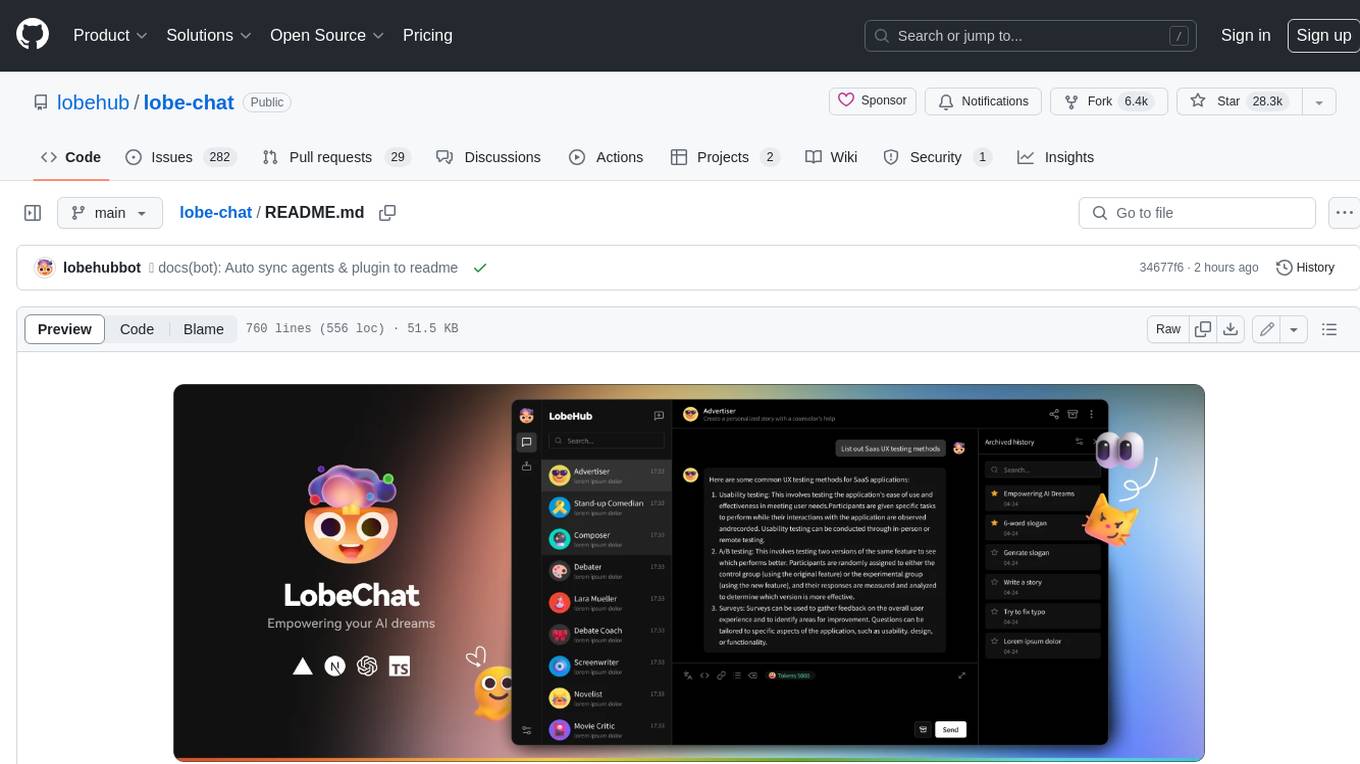
lobe-chat
Lobe Chat is an open-source, modern-design ChatGPT/LLMs UI/Framework. Supports speech-synthesis, multi-modal, and extensible ([function call][docs-functionc-call]) plugin system. One-click **FREE** deployment of your private OpenAI ChatGPT/Claude/Gemini/Groq/Ollama chat application.
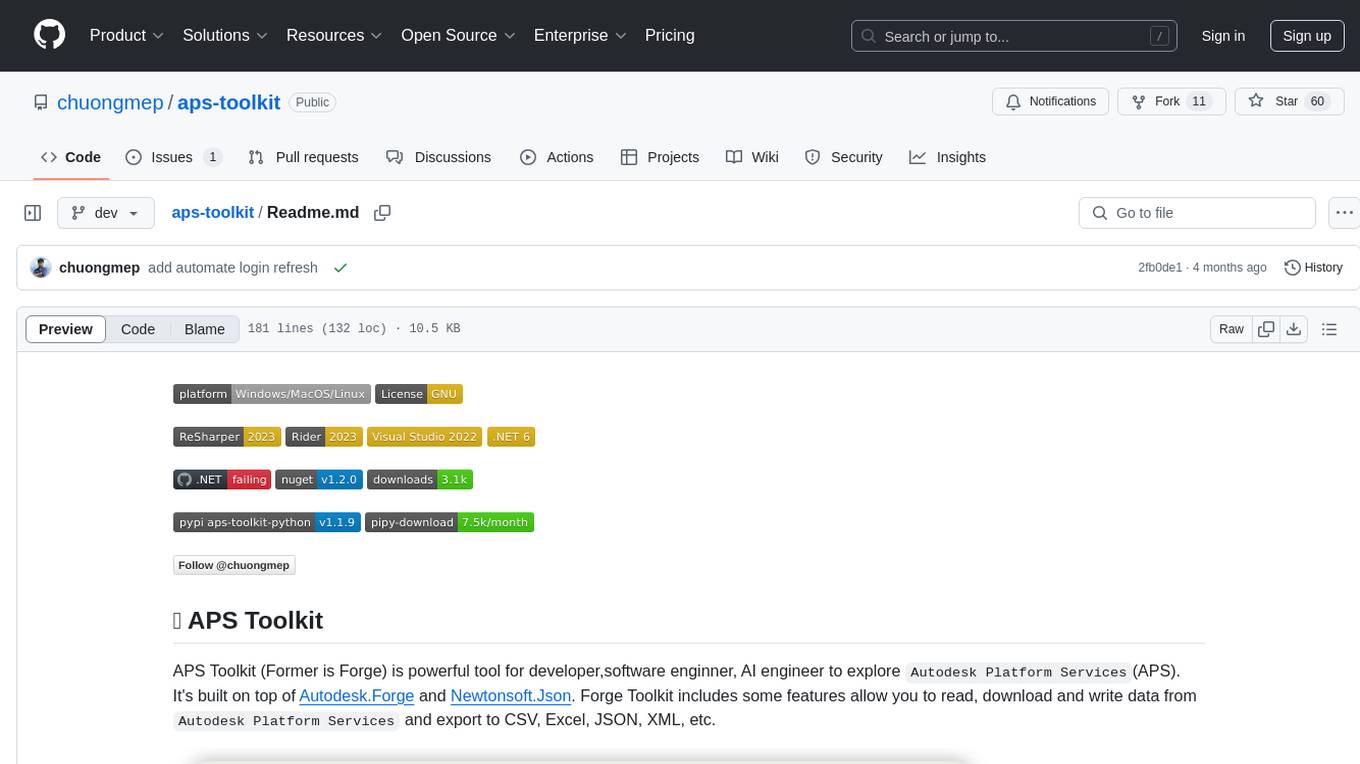
aps-toolkit
APS Toolkit is a powerful tool for developers, software engineers, and AI engineers to explore Autodesk Platform Services (APS). It allows users to read, download, and write data from APS, as well as export data to various formats like CSV, Excel, JSON, and XML. The toolkit is built on top of Autodesk.Forge and Newtonsoft.Json, offering features such as reading SVF models, querying properties database, exporting data, and more.
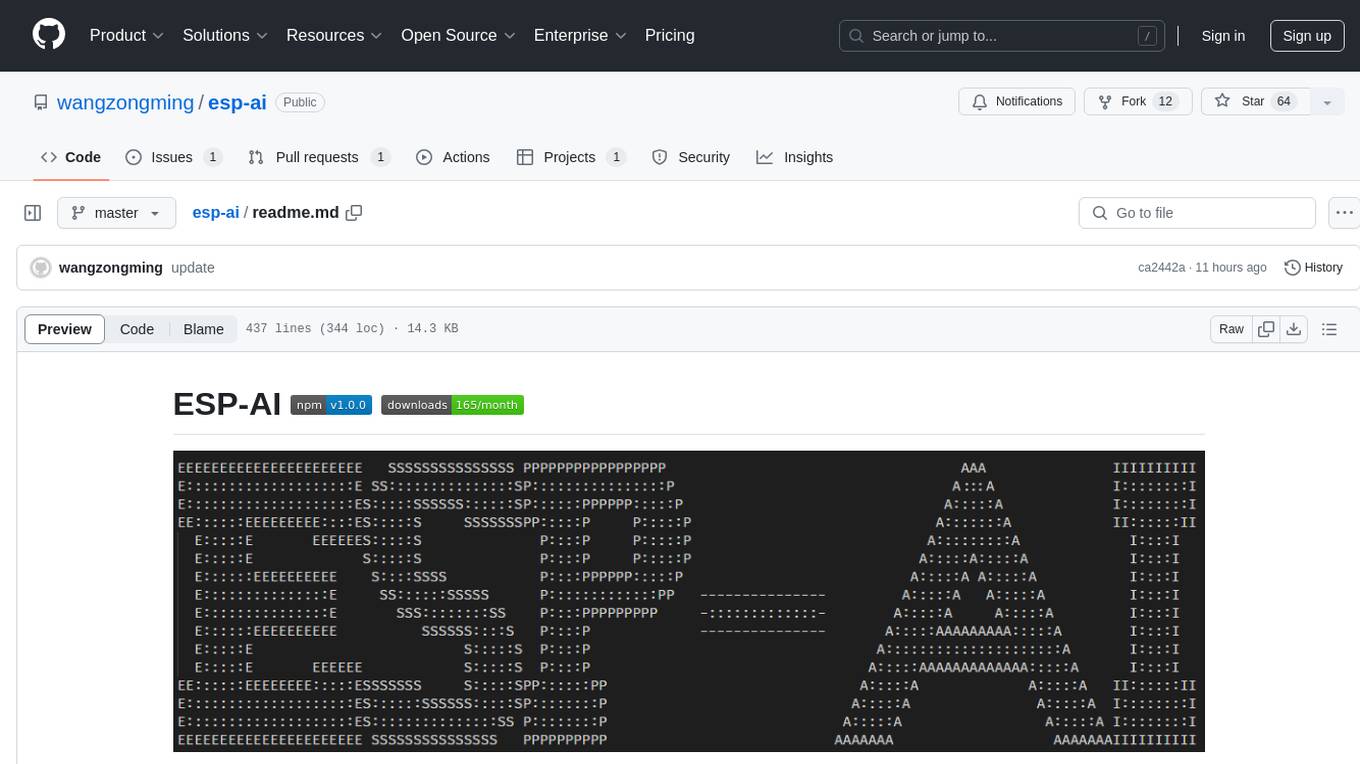
esp-ai
ESP-AI provides a complete AI conversation solution for your development board, including IAT+LLM+TTS integration solutions for ESP32 series development boards. It can be injected into projects without affecting existing ones. By providing keys from platforms like iFlytek, Jiling, and local services, you can run the services without worrying about interactions between services or between development boards and services. The project's server-side code is based on Node.js, and the hardware code is based on Arduino IDE.
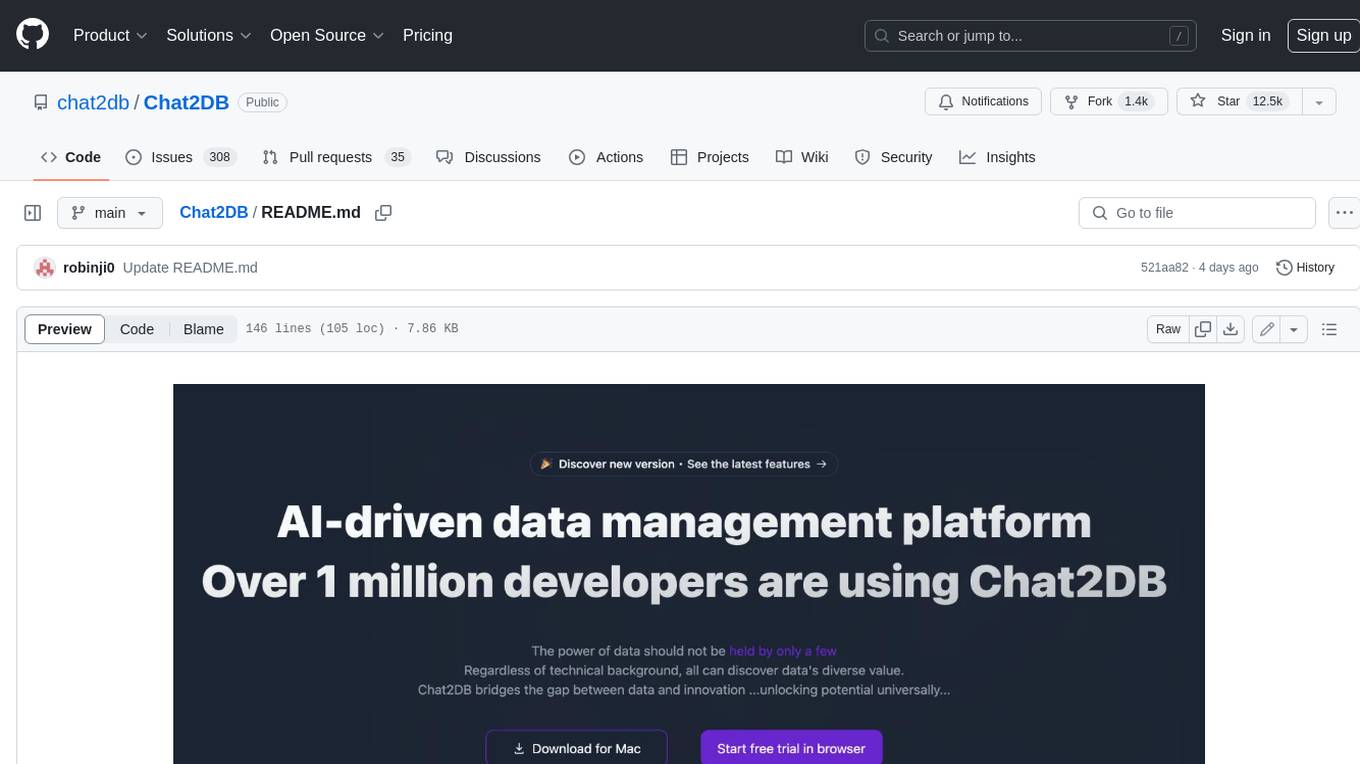
Chat2DB
Chat2DB is an AI-driven data development and analysis platform that enables users to communicate with databases using natural language. It supports a wide range of databases, including MySQL, PostgreSQL, Oracle, SQLServer, SQLite, MariaDB, ClickHouse, DM, Presto, DB2, OceanBase, Hive, KingBase, MongoDB, Redis, and Snowflake. Chat2DB provides a user-friendly interface that allows users to query databases, generate reports, and explore data using natural language commands. It also offers a variety of features to help users improve their productivity, such as auto-completion, syntax highlighting, and error checking.
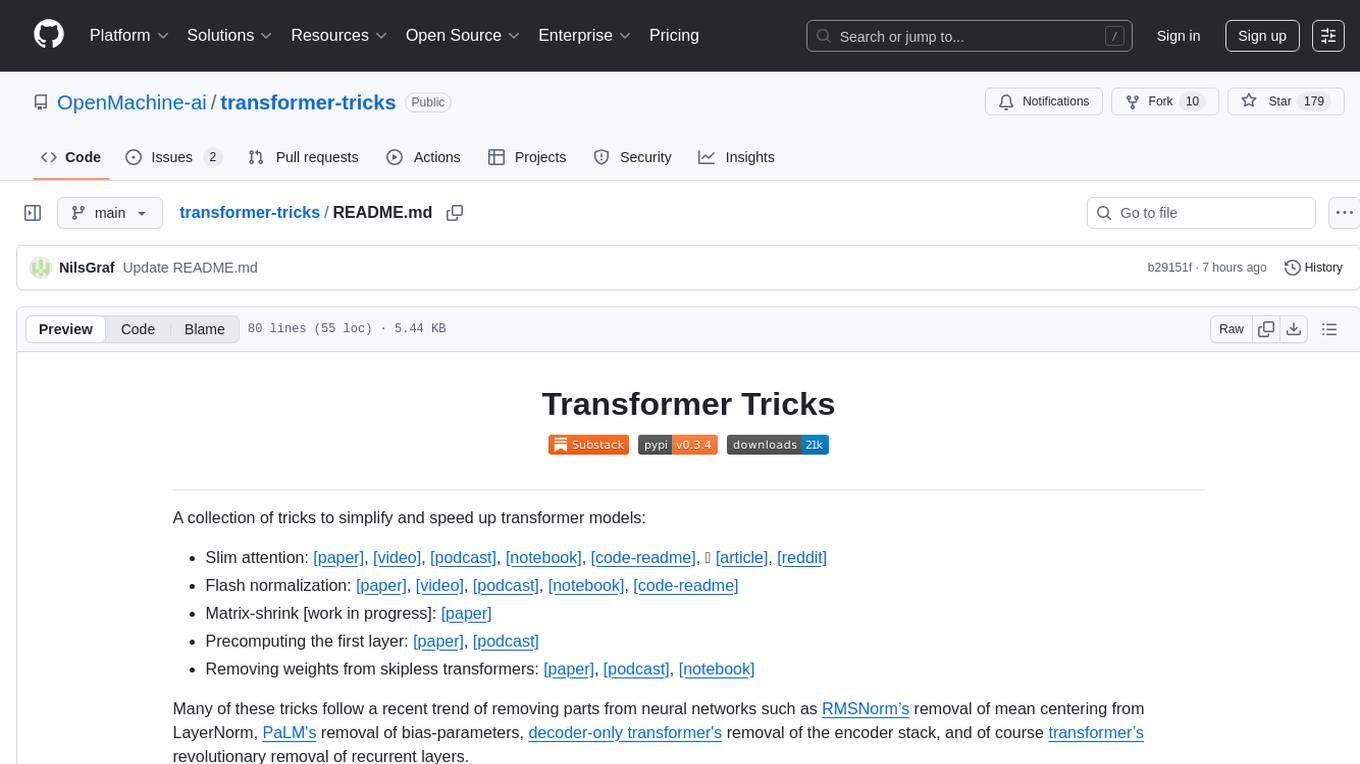
transformer-tricks
A collection of tricks to simplify and speed up transformer models by removing parts from neural networks. Includes Flash normalization, slim attention, matrix-shrink, precomputing the first layer, and removing weights from skipless transformers. Follows recent trends in neural network optimization.
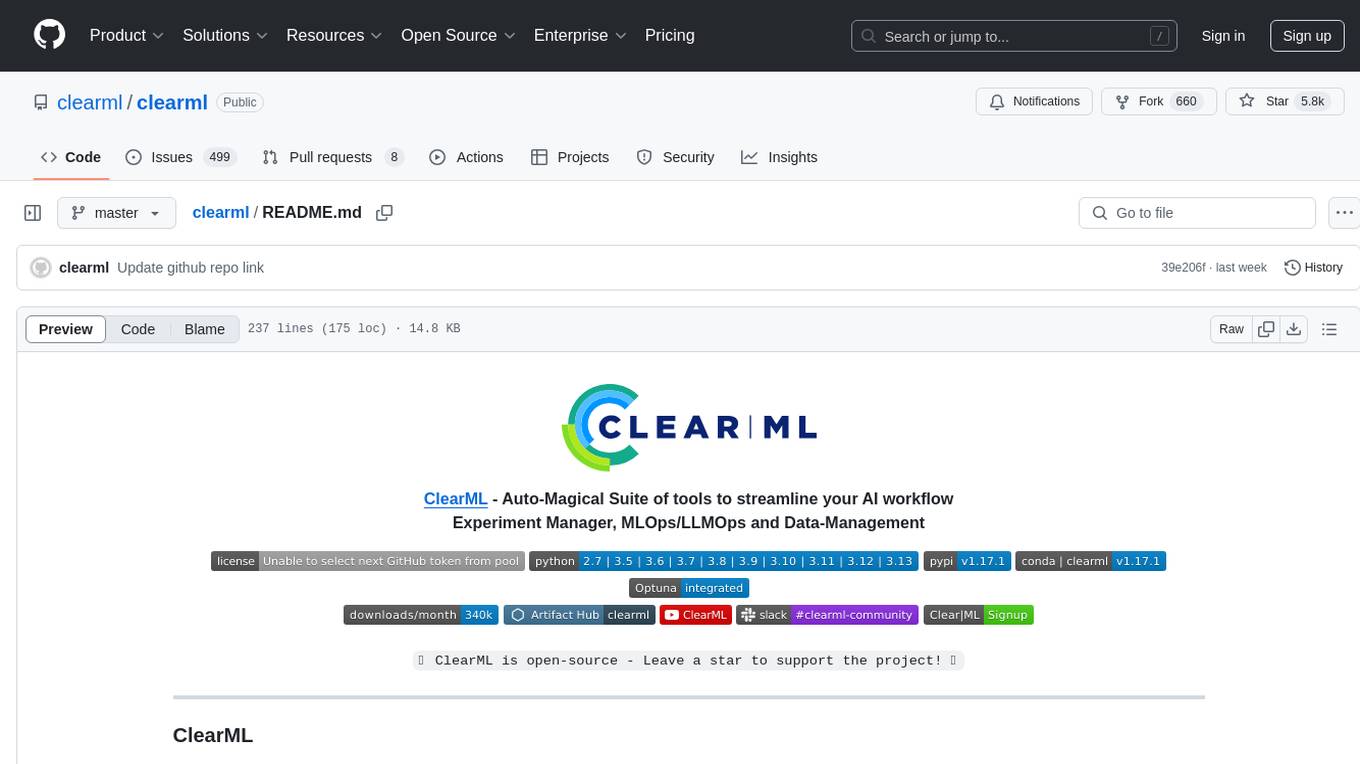
clearml
ClearML is an auto-magical suite of tools designed to streamline AI workflows. It includes modules for experiment management, MLOps/LLMOps, data management, model serving, and more. ClearML offers features like experiment tracking, model serving, orchestration, and automation. It supports various ML/DL frameworks and integrates with Jupyter Notebook and PyCharm for remote debugging. ClearML aims to simplify collaboration, automate processes, and enhance visibility in AI projects.
For similar tasks

LakeSoul
LakeSoul is a cloud-native Lakehouse framework that supports scalable metadata management, ACID transactions, efficient and flexible upsert operation, schema evolution, and unified streaming & batch processing. It supports multiple computing engines like Spark, Flink, Presto, and PyTorch, and computing modes such as batch, stream, MPP, and AI. LakeSoul scales metadata management and achieves ACID control by using PostgreSQL. It provides features like automatic compaction, table lifecycle maintenance, redundant data cleaning, and permission isolation for metadata.

bella-openapi
Bella OpenAPI is an API gateway that provides rich AI capabilities, similar to openrouter. In addition to chat completion ability, it also offers text embedding, ASR, TTS, image-to-image, and text-to-image AI capabilities. It integrates billing, rate limiting, and resource management functions. All integrated capabilities have been validated in large-scale production environments. The tool supports various AI capabilities, metadata management, unified login service, billing and rate limiting, and has been validated in large-scale production environments for stability and reliability. It offers a user-friendly experience with Java-friendly technology stack, convenient cloud-based experience service, and Dockerized deployment.
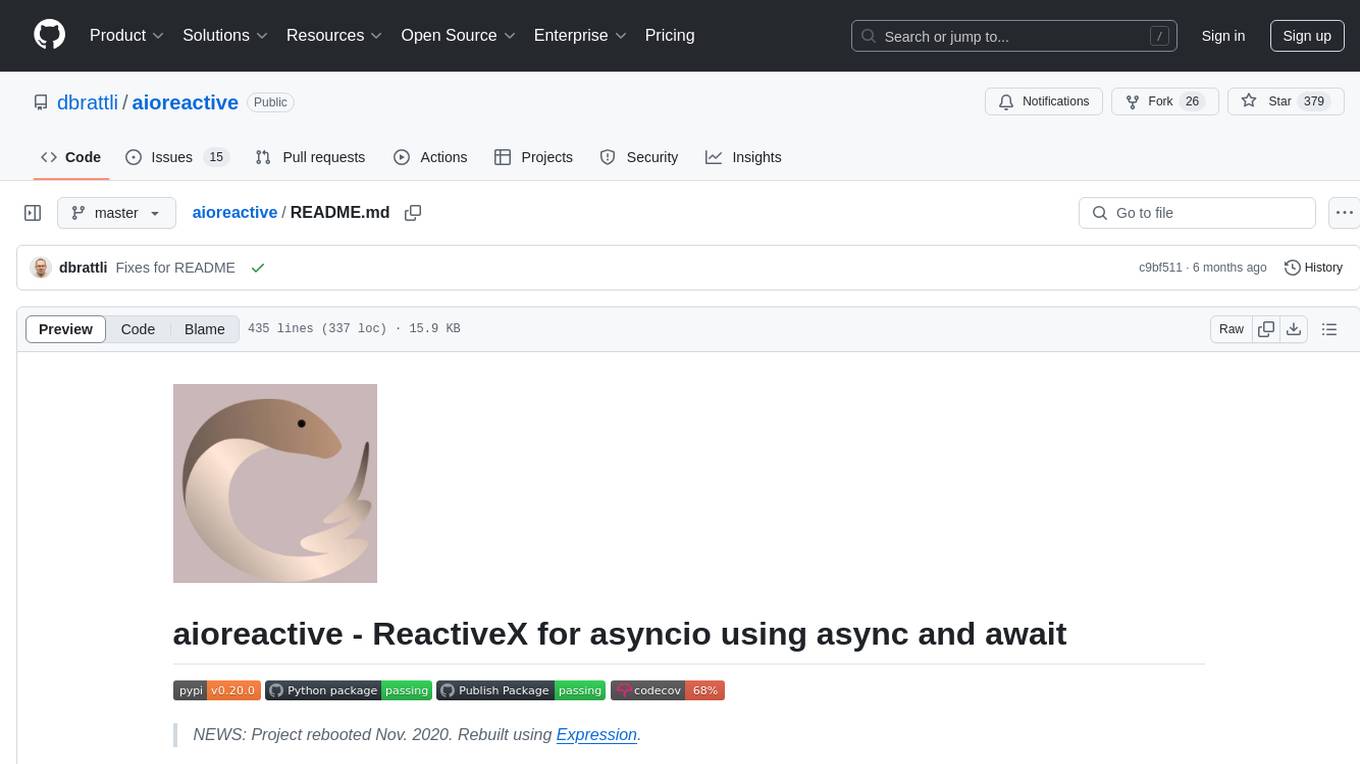
aioreactive
Aioreactive is a Python library that brings ReactiveX functionality to asyncio using async and await. It is built on the Expression functional library and aims to provide a simple, clean, and async-based approach to reactive programming in Python. The library supports Python 3.10+ and focuses on using plain old functions for operators, running on the asyncio event loop, and providing implicit synchronous back-pressure for event processing.
For similar jobs

sweep
Sweep is an AI junior developer that turns bugs and feature requests into code changes. It automatically handles developer experience improvements like adding type hints and improving test coverage.

teams-ai
The Teams AI Library is a software development kit (SDK) that helps developers create bots that can interact with Teams and Microsoft 365 applications. It is built on top of the Bot Framework SDK and simplifies the process of developing bots that interact with Teams' artificial intelligence capabilities. The SDK is available for JavaScript/TypeScript, .NET, and Python.

ai-guide
This guide is dedicated to Large Language Models (LLMs) that you can run on your home computer. It assumes your PC is a lower-end, non-gaming setup.

classifai
Supercharge WordPress Content Workflows and Engagement with Artificial Intelligence. Tap into leading cloud-based services like OpenAI, Microsoft Azure AI, Google Gemini and IBM Watson to augment your WordPress-powered websites. Publish content faster while improving SEO performance and increasing audience engagement. ClassifAI integrates Artificial Intelligence and Machine Learning technologies to lighten your workload and eliminate tedious tasks, giving you more time to create original content that matters.

chatbot-ui
Chatbot UI is an open-source AI chat app that allows users to create and deploy their own AI chatbots. It is easy to use and can be customized to fit any need. Chatbot UI is perfect for businesses, developers, and anyone who wants to create a chatbot.

BricksLLM
BricksLLM is a cloud native AI gateway written in Go. Currently, it provides native support for OpenAI, Anthropic, Azure OpenAI and vLLM. BricksLLM aims to provide enterprise level infrastructure that can power any LLM production use cases. Here are some use cases for BricksLLM: * Set LLM usage limits for users on different pricing tiers * Track LLM usage on a per user and per organization basis * Block or redact requests containing PIIs * Improve LLM reliability with failovers, retries and caching * Distribute API keys with rate limits and cost limits for internal development/production use cases * Distribute API keys with rate limits and cost limits for students

uAgents
uAgents is a Python library developed by Fetch.ai that allows for the creation of autonomous AI agents. These agents can perform various tasks on a schedule or take action on various events. uAgents are easy to create and manage, and they are connected to a fast-growing network of other uAgents. They are also secure, with cryptographically secured messages and wallets.

griptape
Griptape is a modular Python framework for building AI-powered applications that securely connect to your enterprise data and APIs. It offers developers the ability to maintain control and flexibility at every step. Griptape's core components include Structures (Agents, Pipelines, and Workflows), Tasks, Tools, Memory (Conversation Memory, Task Memory, and Meta Memory), Drivers (Prompt and Embedding Drivers, Vector Store Drivers, Image Generation Drivers, Image Query Drivers, SQL Drivers, Web Scraper Drivers, and Conversation Memory Drivers), Engines (Query Engines, Extraction Engines, Summary Engines, Image Generation Engines, and Image Query Engines), and additional components (Rulesets, Loaders, Artifacts, Chunkers, and Tokenizers). Griptape enables developers to create AI-powered applications with ease and efficiency.

